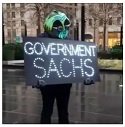the Whole Wall Street Casino Has Become Taxpayer-Backstopped and Too-Big-to-Fail

According to the Federal Deposit Insurance Corporation (FDIC), as of September 30, 2018 there was a total of $13.6 trillion in deposits at all 5,397 Federally insured banking and savings institutions in the U.S. but just nine mega banks represented 40 percent of all domestic deposits. Those nine are the insured banking units of the holding company for JPMorgan Chase with $1.3 trillion in domestic deposits; Bank of America at $1.36 trillion; Wells Fargo with $1.27 trillion; Citigroup at $504 billion; U.S. Bancorp $314 billion; Morgan Stanley $181 billion; BB&T $161 billion; Goldman Sachs $130 billion; and State Street $108 billion.
Unfortunately, the FDIC’s Deposit Insurance Fund had only $100.2 billion as of September 30, 2018 to cover losses should any of those trillion-dollar-banks fail – which means they can’t fail and have thus become known as too-big-to-fail, even as they continue to take massive positions in opaque derivatives.
Even more unfortunate for the American people and the U.S. financial system, six of those mega banks are highly interconnected: JPMorgan Chase, Citigroup, Bank of America, Wells Fargo, Goldman Sachs and Morgan Stanley. We know how interconnected these banks are as a result of studies issued by the Office of Financial Research (OFR), a Federal agency created under the Dodd-Frank financial reform legislation of 2010 to prevent a replay of a handful of Wall Street banks taking down the U.S. financial system again as they did in 2008. We also know just how interconnected these banks are because of how their stocks all trade as a herd when there is fear in the stock market. (See charts above.)
In 2015 OFR released a study showing dangerous levels of systemic and interconnected risk among these mega banks. Authored by Meraj Allahrakha, Paul Glasserman, and H. Peyton Young, the report found the following:
“…the default of a bank with a higher connectivity index would have a greater impact on the rest of the banking system because its shortfall would spill over onto other financial institutions, creating a cascade that could lead to further defaults. High leverage, measured as the ratio of total assets to Tier 1 capital, tends to be associated with high financial connectivity and many of the largest institutions are high on both dimensions…The larger the bank, the greater the potential spillover if it defaults; the higher its leverage, the more prone it is to default under stress; and the greater its connectivity index, the greater is the share of the default that cascades onto the banking system. The product of these three factors provides an overall measure of the contagion risk that the bank poses for the financial system.”
JPMorgan Chase and Citigroup ranked highest in the OFR study in terms of systemic fallout. JPMorgan Chase paid $920 million in fines for its 2012 London Whale saga where it allowed an unlicensed woman, Ina Drew, to supervise traders in London who lost at least $6.2 billion gambling in exotic derivatives using deposits at the U.S. Federally-insured bank. Citigroup received the largest taxpayer-bailout in U.S. history during the financial crisis. Its haul included an infusion of $45 billion in capital from the U.S. Treasury; a government guarantee of over $300 billion on its dubious assets; a guarantee of $5.75 billion on its senior unsecured debt and $26 billion on its commercial paper and interbank deposits by the FDIC; and a secret revolving loan facility from the Federal Reserve that sluiced a cumulative $2.5 trillion in below-market-rate loans from 2007 to the middle of 2010 to Citigroup.



